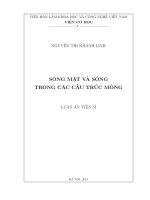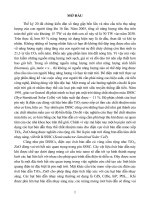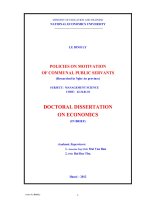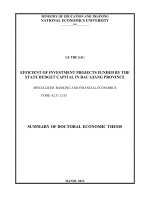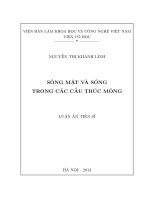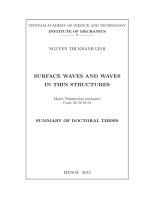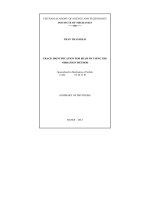TÓM tắt TIẾNG ANH LUẬN án SÓNG mặt và SÓNG TRONG các cấu TRÚC MỎNG
Bạn đang xem bản rút gọn của tài liệu. Xem và tải ngay bản đầy đủ của tài liệu tại đây (402.14 KB, 25 trang )
VIETNAM ACADEMY OF SCIENCE AND TECHNOLOGY
INSTITUTE OF MECHANICS
———– * ———–
NGUYEN THỊ KHANH LINH
SURFACE WAVES AND WAVES
IN THIN STRUCTURES
Major: Engineering mechanics
Code: 62 52 01 01
SUMMARY OF DOCTORAL THESIS
HANOI – 2013
Supervisor:
Assoc. Prof. Dr. Pham Chi Vinh
Referee 1:
Referee 2:
Referee 3:
The thesis is protected to the Council assessing
doctoral dissertation level Institute, meeting at the
Institute of Mechanics, 264 Doi Can - Ba Dinh - Ha Noi.
At hours and minutes, , 20
1
Chapter 1. Survey
Actuality of the thesis
Problems of elastic wave propagation, especially the ones of Rayleigh
wave propagration, are the foundation of various practical applications
in science and technology.
Elastic surface waves, discovered by Rayleigh more than 120 years
ago for compressible isotropic elastic solids, have been studied exten-
sively and exploited in a wide range of applications in seismology, acous-
tics, geophysics, telecommunications industry and materials science, for
example. It would not be far-fetched to say that Rayleigh’s study of
surface waves upon an elastic half-space has had fundamental and far-
reaching effects upon modern life and many things that we take for
granted today, stretching from mobile phones through to the study of
earthquakes, as addressed by Adams et al A huge number of investiga-
tions have been devoted to this topic. As written in, one of the biggest
scientific search engines Google.Scholar returns more than a million
links for request "Rayleigh waves" and almost 3 millions for "Surface
waves". This data is really amazing! It shows a tremendous scale of
scientific and industrial interests in this area.
The structure of a half-space coated by a thin layer is widely ap-
plied in modern technology. The measurement of mechanical properties
of thin films deposited on half-spaces before and during loading is of
importance and of great necessaries. Note that there exists an interna-
tional journal named “Thin Solid Films” which is for publishing new
research results in the fileld of thin solid films. For non-destructively
evaluating the mechanical properties of materials, the Rayleigh wave is
a convenient tool. When using the Rayleigh wave for non-destructively
evaluating, its explicit dispersion relations are employed as theoretical
bases for extracting the mechanical properties of the thin films from
experimental data.
Nowadays, composite materials, especially the ones with fibers, are
widely used in various fields of science and industry, such as the man-
ufacture of automobiles, the manufacture of aircrafts, the manufacture
of ships . .In order to manufacture a ship shell, for example, thin
fiber/epoxy layers with different fiber-directions are attached periodi-
cally to each other, up to a given thickness. The ship shell can be there-
2
fore considered as infinite, periodically layered, elastic media. Thus, the
problems on waves propagating in infinite, periodically layered, elastic
media are needed to investigate and they attract a great attention of
researchers.
The main purposes of the thesis
• Applying new methods to develop some problems on Rayleigh
waves that were investigated previously.
• Deriving approximate secular equations of Rayleigh waves prop-
agating in elastic half-spaces coated an elastic thin layer.
• Investigating SH wave and Lamb wave propagting in periodical
and thin structures.
Research objects
Waves propagating in elastic half-spaces, waves propagating in elas-
tic half-spaces coated with a thin elastic layer, waves propagating in
periodical, thin structures.
Research range
Exact and approximate secular equations of Rayleigh waves and
formulas for the Rayleigh wave velocity.
Research methods
The method of cubic equation, the method of least squares, the
perturbation method, the method of effective boundary condition, the
method of polarization vector and the asymptotic method.
Chapter 2. Rayleigh waves
2.1 Rayleigh waves in incompressible elastic media
subjected to gravity
2.1.1 Secular equation
Consider the problem of Rayleigh wave propagation in an incompress-
ible isotropic elastic half-space x
3
≥ 0 (Figure 2.1) subjected to gravity.
3
Figure 2.1. The problem model
The secular equation is:
(2 − x)
2
− 4
√
1 − x − δx = 0, (1)
where δ = ρg/(kµ) ≥ 0, x = c
2
/c
2
2
, c
2
=
µ/ρ, k is number wave, c is
velocity, µ is Lame constant, ρ is mass density of the medium, g is the
acceleration due to gravity.
When δ = 0, equation (1) becomes:
(2 − x)
2
− 4
√
1 − x = 0. (2)
Equation (2) is the secular equation of Rayleigh waves in an incom-
pressible isotropic elastic half-space without the effect of gravity.
2.1.2 Formulas for the velocity of Rayleigh waves
Exact formulas for the velocity of Rayleigh waves
Using the theory of cubic equation, we obtain the exact expressions
for the velocity:
x
r
=
2(4 + δ)
3
−
3
16(δ + 11)(δ
2
+ 4)/27 + (δ
3
+ 12δ
2
+ 12δ + 136)/27
+
8 − 8δ − δ
2
9
3
16(δ + 11)(δ
2
+ 4)/27 + (δ
3
+ 12δ
2
+ 12δ + 136)/27
, δ ∈ [0 , 1).
(3)
x
r
=1−
3
26 − 9δ
27
+
(δ + 11)(δ
2
+ 4)
27
−
8 + 3δ
9
3
26−9δ
27
+
(δ+11)(δ
2
+4)
27
−
1
3
2
.
(4)
4
Approximate formulas for the velocity of Rayleigh waves
By applying the method of least squares, we drive approximate
formulas for the velocity of Rayleigh waves:
x
1
=
B −
√
B
2
− 4AC
2A
, (5)
with A = −(5.1311 + 2δ), B = −(21.2576 + 8δ + δ
2
), C = −(15.1266 +
8δ).
x
2
= 1 −
−(2.9475724 + δ) +
√
δ
2
+ 0.1215448δ + 14.4543266
2.8868
2
.
(6)
2.1.3 The existence Rayleigh waves
Theorem 2.1 Let δ ≥ 0, then:
(i) A Rayleigh wave exsists if and if 0 ≤ δ < 1.
(ii) If a Rayleigh wave exists, then it is unique, and its squared di-
mensionless velocity x
r
(δ) is given by Eqs. (3) or (4).
(iii) The squared dimensionless Rayleigh wave velocity x
r
is a strictly
monotonously increasing function in the interval [0 , 1), from x
0
to 1 (but not equal to 1), where:
x
0
= 1 −
26
27
+
2
3
11
3
1/3
−
8
9
26
27
+
2
3
11
3
−1/3
−
1
3
2
.
(7)
2.1.4 Conclusion
In this paper, the exact and highly accurate approximate formulas for
the velocity of Rayleigh waves in an incompressible isotropic elastic
half-space under gravity are derived. These formulas are useful tools
for evaluating the effect of gravity on propagation of Rayleigh waves
and for solving the inverse problem as well. They are new results and
have been published in Acta Mechanica, Vol. 223, 1537-1544, 2012.
5
2.2 Rayleigh waves semi-infinite orthotropic thin
plates
2.2.1 Principal Rayleigh waves
2.2.1.1 Secular equation
Consider a thin semi-infinite orthotropic medium (panel) occupying
the half-space x
2
≥ 0, its principal material axes are x
1
, x
2
and x
3
axis
(Figure 2.5) and it is in the state of plane stress.
Figure 2.5. The model for pricipal Rayleigh waves
From basic equations and boundary condition, we obtain the secular
equation, namely:
(B
66
− ρc
2
)[B
2
12
− B
22
(B
11
− ρc
2
)]
+ρc
2
B
22
B
66
(B
11
− ρc
2
)(B
66
− ρc
2
) = 0 (8)
where: B
ij
are material (stiffness) coefficients which can be expressed in
terms of the engineering constants (Young’s and shear moduli, Poisson’s
ratios) as:
B
11
=
E
1
1 − ν
12
ν
21
, B
22
=
E
2
1 − ν
12
ν
21
,
B
12
=
ν
21
E
1
1 − ν
12
ν
21
=
ν
12
E
2
1 − ν
12
ν
21
, B
66
= G
12
,
(9)
Remark: The secular equation (8) is much more simple than the sec-
ular equations of Cerv and valid for any orthotropic elastic materials.
2.2.1.2 Formulas for the velocity
Exact formula
6
Following the same procedure carried out in [Pham Chi Vinh and
Ogden, R. W., Ach. Mech., 56 (3) (2004), 247-265], formula for the
velocity of Rayleigh waves is derived:
ρc
2
/B
66
=
√
b
1
b
2
b
3
/
(
√
b
1
/3)(b
2
b
3
+2)+
3
R+
√
D+
3
R −
√
D
(10)
where b
1
= B
22
/B
11
, b
2
= 1 −B
2
12
/(B
11
B
22
), b
3
= B
11
/B
66
, R and D
are given by:
R = −
1
54
h(b
1
, b
2
, b
3
),
D = −
1
108
2
√
b
1
(1 − b
2
) h(b
1
, b
2
, b
3
) + 27b
1
(1 − b
2
)
2
+ b
1
(1 − b
2
b
3
)
2
+ 4
,
h(b
1
, b
2
, b
3
) =
√
b
1
[2b
1
(1 − b
2
b
3
)
3
+ 9(3b
2
− b
2
b
3
− 2)] (11)
and the roots in (10) taking their principal values. Three dimensionless
parameters b
k
are expressed in terms E
1
, E
2
, G
12
, ν
12
as:
b
1
=
E
2
E
1
, b
2
= 1 −
E
2
ν
2
12
E
1
, b
3
=
E
2
1
G
12
(E
1
ν
2
12
− E
2
5)
(12)
Approximate formulas
Using the method of least squares, we obtain approximate formulas:
x
1
=
B
1
−
B
2
1
− 4A
1
C
1
2A
1
,
A
1
=b
1
b
3
[b
3
(1 + 0.5b
1
− 2b
1
b
2
b
3
) − 1.5],
B
1
=b
1
b
3
[0.6(b
1
b
3
− 1) − b
1
b
2
b
2
3
(b
2
b
3
+ 2)],
C
1
=0.05b
1
b
3
(b
1
b
3
− 1) − b
2
1
b
2
2
b
4
3
(13)
x
2
=
B
2
−
B
2
2
− 4A
2
C
2
2A
2
,
A
2
=b
1
b
3
[b
3
(1 + 0.5b
1
− 2b
1
b
2
b
3
) − 1.5],
B
2
=b
1
b
3
[0.5625(b
1
b
3
− 1) − b
1
b
2
b
2
3
(b
2
b
3
+ 2)],
C
2
=0.03125b
1
b
3
(b
1
b
3
− 1) − b
2
1
b
2
2
b
4
3
(14)
Remark: Approximate formulas for the velocity (13), (14) are highly
accurate.
7
2.2.2 Non-principal Rayleigh waves
2.2.2.1. Secular equation
Consider a thin homogeneous orthotropic elastic panel occupying
the half-space x
2
≥ 0 whose principal material axes are X, Y, Z (hình
2.9). Suppose that the Z axis coincides with the x
3
axis and (x
1
, x
2
)
Figure 2.9. The model of non-principal Rayleigh waves
is the rotated one from (X, Y ) by counter clockwise angle θ. Suppose
that the panel is subjected to the plane stress state.
Using the method of first integrals, we derive the secular equation:
F (X, θ) ≡dX
2
[(d + d
2
)X −d
3
][d
2
2
− Q
66
(dX −d
3
)]
+ (dX −d
3
)[(d+d
2
)X −d
3
][Q
22
dX
2
−(d
2
+d
2
1
+Q
22
d
3
)X +dd
3
]
− 2d
1
X
2
(dX −d
3
)[Q
26
(dX −d
3
) − d
1
d
2
] = 0 (15)
where X = ρc
2
and
Q
11
= B
11
c
4
θ
+ 2(B
12
+ 2B
66
)c
2
θ
s
2
θ
+ B
22
s
4
θ
,
Q
22
= B
11
s
4
θ
+ 2(B
12
+ 2B
66
)c
2
θ
s
2
θ
+ B
22
c
4
θ
,
Q
12
= (B
11
+ B
22
− 4B
66
)c
2
θ
s
2
θ
+ B
12
(c
4
θ
+ s
4
θ
), (16)
Q
66
= (B
11
+ B
22
− 2B
12
− 2B
66
)c
2
θ
s
2
θ
+ B
66
(c
4
θ
+ s
4
θ
),
Q
16
= −(B
11
− B
12
− 2B
66
)c
3
θ
s
θ
− (B
12
− B
22
+ 2B
66
)c
θ
s
3
θ
,
Q
26
= −(B
11
− B
12
− 2B
66
)c
θ
s
3
θ
− (B
12
− B
22
+ 2B
66
)c
3
θ
s
θ
,
d = Q
22
Q
66
− Q
2
26
, d
1
= Q
12
Q
26
− Q
22
Q
16
d
2
= Q
12
Q
66
− Q
16
Q
26
, d
3
= Q
11
d + Q
16
d
1
− Q
12
d
2
.
with c
θ
:= cosθ, s
θ
:= sinθ (0 ≤ θ ≤ π).
8
2.2.3 Conclusion
In this chapter we obtain the secular equation for principal Rayleigh
waves that is valid for all orthotropic elastic materials and much more
simple than the ones obtained recently by Cerv. Exact and approx-
imate formulas for the velocity of principal Rayleigh-edge waves are
also established and they are a powerful tool for analyzing the effect of
material parameters on the Rayleigh wave velocity. For non-principal
Rayleigh waves a secular equation in explicit form is obtained by us-
ing the method of first integrals. They are new results and have been
published "Vietnam Journal of Mechanics, 34 (2) (2012), 123 – 134"
Chapter 3. Rayleigh waves in elastic half-
spaces underlying a water layer
3.1 The exact secular equation
Consider an incompressible isotropic elastic half-space x
3
≥ 0 that is
overlaid with a layer of incompressible non-viscous water occupying the
domain 0 ≤ x
3
≤ h (see Figure 3.1). Both the elastic half-space and
the water layer are assumed to be under the gravity
Figure 3.1. The problem model
From the basic equations, the boundary conditions at x
3
= h and the
continuity conditions at x
3
= 0, we obtain the secular equation:
(2 − x)
2
− 4
√
1 − x − δ x + r δ x − r f (x, δ, ε)x
2
= 0, 0 < x < 1 (17)
where: x = c
2
/c
2
2
, c
2
=
µ/ρ , δ = g/kc
2
2
, ε = kh, r =
ρ
ρ
, f (x, δ, ε) =
(δ −xthε)/(x −δthε), c is velocity, µ and ρ are Lame contants and the
mass density of the medium, g is the acceleration due to gravity, k is
the wave number, ρ
is the mass density of the water
9
Remark: To the best knowledge of the authors the exact secular equa-
tion (17) did not appear in the literature. It is shown the approximate
secular equation obtained by Bromwich is a special case of (17).
3.1.2. On existence of Rayleigh waves
Theorem 3.1.
i) A Rayleigh wave is impossible if either {δ ≥ 1, 0 < δthε ≤ 1,
r ≥ 1 + 2/δ} or {δ ≥ 1, δthε > 1, r ∈ (0, m] ∪[1 + 2/δ, +∞)}.
ii) There exists a unique Rayleigh wave, namely CRW, if {0 < δ < 1,
r ≥ 1 + 2/δ}.
iii) There exists a unique Rayleigh wave, namely GRW, if either {δ ≥
1, 0 < δthε ≤ 1, 0 < r < 1 + 2/δ} hoặc {δ ≥ 1, δthε > 1,
m < r < 1 + 2/δ}.
iv) There exist exactly two Rayleigh waves, one CRW and one GRW,
if {0 < δ < 1, 0 < r < 1 + 2/δ}.
3.1.3. Approximate secular equation
Suppose that h is small (the layer is thin). From the equation (17),
we obtain the fourth-order approximate secular equation, namely:
F (x, δ, ε) ≡ (2 − x)
2
− 4
√
1 − x − δ x − r(δ
2
− x
2
)ε − r
δ
3
x
− δ x
ε
2
− r
δ
4
x
2
−
4δ
2
3
+
x
2
3
ε
3
− r
δ
5
x
3
−
5δ
3
3x
+
2δ x
3
ε
4
= 0, δthε < x < 1
(18)
3.2. Approximate formulas for the velocity
Both δ and ε being small
By using the perturbation method, we obtain the second-order ap-
proximation of the squared dimensionless velocity of Rayleigh waves:
x
x
0
= 1+0.1089δ−0.0994rε−0.0782δ
2
+0.1211r δε−0.0453r
2
ε
2
(19)
Only ε being small
The second-order approximation of x(ε) is:
x(ε) = x
0
+
r(δ
2
− x
2
0
)ε
a
1
+ a
2
ε
2
, (20)
a
1
= 2(x
0
− 2) + 2(1 − x
0
)
−1/2
− δ,
10
a
2
=−
2+(1−x
0
)
−
3
2
r
2
(δ
2
− x
2
0
)
2
a
3
1
−
4r
2
x
0
(δ
2
−x
2
0
)
a
2
1
−
2rδ
x
0
−
δ
2
x
0
a
1
,
where x
0
is calculated by (7).
Global approximation
Suppose that the water layer is thin: ε << 1, by using the method
of least squares, we derive the global approximation:
x =
−B +
√
B
2
− 4AC
2A
(21)
A = 5.4364(1+ε
∗
)
2
+8δ−2ε
∗
δ
2
+8ε
∗
+δ
2
−2ε
∗
2
δ
2
+ 24−2.8551(8+2δ)(1+ε
∗
)
B = −6.8944(1 + ε
∗
)
2
− 16 + 8ε
∗
δ
2
+ 2δ
3
ε
∗
− 8δ + 2.7158(8 + 2δ)(1 + ε
∗
)
C = 2.4578(1 + ε
∗
)
2
− 8ε
∗
δ
2
− 0.8607(8 + 2δ)(1 + ε
∗
) + ε
∗
2
δ
4
, với ε
∗
= rε.
3.3. Conclusion
In this chapter, the exact secular equation of the wave is derived
and based on it the existence of Rayleigh waves is examined. When
the layer being thin, a fourth-order approximate secular equation is
established and using it some approximate formulas for the velocity
are established. The results of this chapter have been published in the
journal "Meccanica, Vol. 48, pp.2051-2060, 2013"
Chapter 4. Rayleigh waves in a half-space
coated by a thin layer
4.1 Rayleigh waves in a compressible orthotropic
elastic half-space coated by a thin orthotropic
elastic layer
4.1.1 Effective boundary condition of third-order
Consider an elastic half-space x
2
≥ 0 coated by a thin elastic layer −h ≤
x
2
≤ 0. Both the layer and the half-space are homogeneous, orthotropic
and elastic. The thin layer is assumed to be perfectly bonded to the
half-space.
11
Figure 4.1. The problem moldel
By using the effective boundary condition method, the entire effect of
the layer on the half-space is replaced by effective boundary conditions,
namely:
σ
12
+ h(r
1
σ
22,1
− r
3
u
1,11
− ¯ρ¨u
1
)
+
h
2
2
r
2
σ
12,11
+
¯ρ
¯c
66
¨σ
12
− r
3
u
2,111
− ¯ρ(1 + r
1
)¨u
2,1
+
h
3
6
r
4
σ
22,111
+ ¯ρr
5
¨σ
22,1
− r
6
u
1,1111
− ¯ρr
7
¨u
1,11
−
¯ρ
2
¯c
66
¨u
1,tt
= 0
tại x
2
= 0,
(22)
σ
22
+h(σ
12,1
−¯ρ¨u
2
)+
h
2
2
r
1
σ
22,11
+
¯ρ
¯c
22
¨σ
22
−r
3
u
1,111
−¯ρ(1+r
1
)¨u
1,1
+
h
3
6
r
2
σ
12,111
+ ¯ρr
8
¨σ
12,1
−r
3
u
2,1111
−¯ρ(1+2r
1
)¨u
2,11
−
¯ρ
2
¯c
22
¨u
2,tt
= 0
tại x
2
= 0,
(23)
where σ
ij
, u
i
are respectively the stresses and the displacements of the
substrate, ¯c
ij
, ¯ρ are respectively the material constants and the mass
density of the layer, a dot signifies differentiation with respect to t,
commas indicate differention with respect to spatial variables x
k
and
r
1
=
¯c
12
¯c
22
, r
2
= r
1
+
r
3
¯c
66
, r
3
=
¯c
2
12
− ¯c
11
¯c
22
¯c
22
, r
4
= r
1
r
2
+
r
3
¯c
22
,
r
5
=
1 + r
1
¯c
22
+
r
1
¯c
66
, r
6
= (r
1
+ r
2
)r
3
, r
7
= r
2
1
+ 2r
2
, r
8
=
1 + r
1
¯c
66
+
1
¯c
22
.
4.1.2 An approximate secular equation of third-order
Using expressions of the stresses and the displacements of the half-space
into the effective boundary conditions (22), (23) leads to the dispersion
equation of the wave, namely
D
0
+ D
1
ε +
D
2
2
ε
2
+
D
3
6
ε
3
+ O(ε
4
) = 0, (24)
12
in which:
D
0
=(e
2
3
− e
1
e
2
+ e
2
x)b
1
b
2
+ (e
1
− x)x,
D
1
=r
µ
(e
1
− x)r
2
v
x + e
2
(¯e
2
¯e
2
3
− ¯e
1
+ r
2
v
x)b
1
b
2
(b
1
+ b
2
),
D
2
= −
¯e
2
¯e
2
3
− ¯e
1
+ (1 + ¯e
2
)r
2
v
x
D
0
+ 2r
µ
e
3
(¯e
1
− ¯e
2
¯e
2
3
) + (¯e
2
¯e
3
e
3
− e
3
− r
µ
¯e
2
¯e
2
3
+ r
µ
¯e
1
)r
2
v
x − r
µ
r
4
v
x
2
b
1
b
2
+2r
µ
¯e
1
− ¯e
2
¯e
2
3
+ (¯e
2
¯e
3
− 1 + r
µ
¯e
2
¯e
2
3
− r
µ
¯e
1
)r
2
v
x + r
µ
r
4
v
x
2
(x − e
1
),
D
3
= r
µ
(x−e
1
)
2(¯e
1
−¯e
2
¯e
2
3
)+(3¯e
2
¯e
2
3
+2¯e
2
¯e
3
−3¯e
1
−2)r
2
v
x+(3+ ¯e
2
)r
4
v
x
2
−e
2
(2¯e
2
¯e
3
+¯e
2
¯e
2
3
−¯e
1
)(¯e
2
¯e
2
3
−¯e
1
)
+ (¯e
2
2
¯e
2
3
+ 2¯e
2
¯e
3
+ 2¯e
2
¯e
2
3
− 2¯e
1
− 3¯e
1
¯e
2
)r
2
v
x
+ (1 + 3¯e
2
)r
4
v
x
2
b
1
b
2
(b
1
+ b
2
),
với b
1
b
2
=
√
P , b
1
+ b
2
=
S + 2
√
P , S =
e
2
(e
1
−x) +1 −x − (1 +e
3
)
2
e
2
,
P =
(1 − x)(e
1
− x)
e
2
, x =
ρc
2
c
66
, e
1
=
c
11
c
66
, e
2
=
c
22
c
66
, e
3
=
c
12
c
66
,
¯e
1
=
¯c
11
¯c
66
, ¯e
2
=
¯c
66
¯c
22
, ¯e
3
=
¯c
12
¯c
66
, r
µ
=
¯c
66
c
66
, r
v
=
c
2
¯c
2
, c
2
=
c
66
ρ
, ¯c
2
=
¯c
66
¯ρ
and c
ij
, ρ are respectively the material constants and the mass density
of the half-space, c (> 0) is wave velocity, k (> 0) is the wave number ,
ε = kh. It is clear that the squared dimensionless Rayleigh wave velocity
x = c
2
/c
2
2
depend on 9 dimensionless parameters: r
µ
, r
v
, e
k
, ¯e
k
, k =
1, 2, 3 and ε.
4.1.3 An approximate formula of second-order for
the velocity
Let ε be small, we have
x(ε) = x
0
+ x
(0) ε +
x
(0)
2
ε
2
+ O(ε
3
) (25)
13
where x
0
= x(0) is the squared dimensionless velocity of Rayleigh waves
propagating in an orthotropic elastic half-space that is given by:
x
0
=
√
s
1
s
2
s
3
/
(
√
s
1
/3)(s
2
s
3
+ 2) +
3
R +
√
D +
3
R −
√
D
(26)
s
1
= e
2
/e
1
, s
2
= 1 − e
2
3
/(e
1
e
2
), s
3
= e
1
x
(0) = −
D
1
D
0x
x=x
0
, x
(0) = −
D
0xx
D
2
1
− 2D
1x
D
1
D
0x
+ D
2
D
2
0x
D
3
0x
x=x
0
and R, D are given by (11) in which b
1
, b
2
, b
3
are substitutied by
s
1
, s
2
, s
3
.
4.2 Rayleigh waves in an incompressible orthotropic
elastic half-space coated by a thin orthotropic
elastic layer
4.2.1 Effective boundary condition of third-order
Consider an elastic half-space x
2
≥ 0 coated by a thin elastic layer
−h ≤ x
2
≤ 0. The layer and the half-space are both homogeneous,
incompressible, orthotropic. The thin layer is assumed to be perfectly
bonded to the half-space (see Figure 4.1).
By using the effective boundary condition method, the entire ef-
fect of the layer on the half-space is replaced by effective boundary
conditions, namely:
σ
12
+ h(σ
22,1
+
¯
δu
1,11
− ¯ρ¨u
1
) +
h
2
2
(r
1
σ
12,11
+
¯ρ
¯c
66
¨σ
12
+
¯
δu
2,111
− 2¯ρ¨u
2,1
)
+
h
3
6
(r
1
σ
22,111
+
¯ρ
¯c
66
¨σ
22,1
− r
2
u
1,1111
− ¯ρr
3
¨u
1,11
−
¯ρ
2
¯c
66
¨u
1,tt
) = 0
at x
2
= 0, (27)
σ
22
+ h(σ
12,1
− ¯ρ¨u
2
) +
h
2
2
(σ
22,11
+
¯
δu
1,111
− 2¯ρ¨u
1,1
)
+
h
3
6
(r
1
σ
12,111
+
2¯ρ
¯c
66
¨σ
12,1
+
¯
δu
2,1111
− 3¯ρ¨u
2,11
) = 0 at x
2
= 0, (28)
where:
¯
δ = ¯c
11
+¯c
22
−2¯c
12
, r
1
= 1−
¯
δ
¯c
66
, r
2
=
¯
δ(
¯
δ
¯c
66
−2), r
3
= 2r
1
+1.
14
4.2.2 An approximate secular equation of third-order
Subtituting expressions of the stresses and the displacements of the
half-space into the effective boundary conditions (27), (28) leads to the
dispersion equation of the wave, namely:
D
0
+ D
1
ε +
D
2
2
ε
2
+
D
3
6
ε
3
+ O(ε
4
) = 0, (29)
where:
D
0
=(x − e
δ
)(
√
P −1) −S − P − 1,
D
1
=r
µ
r
2
v
x + (xr
2
v
− ¯e
1
− ¯e
2
+ 2¯e
3
)
√
P
S + 2
√
P ,
D
2
= −
xr
2
v
− ¯e
δ
D
0
− 2r
2
µ
r
2
v
x
xr
2
v
− ¯e
δ
+ r
µ
¯e
δ
(x − e
δ
+ S + 2
√
P ),
D
3
= − r
µ
S + 2
√
P
−3xr
2
v
(¯e
δ
− xr
2
v
) + 2¯e
δ
+
√
P
¯e
δ
(¯e
δ
− 2) + xr
2
v
(xr
2
v
− 2¯e
δ
)
,
¯e
δ
=¯e
1
+ ¯e
2
− 2¯e
3
, e
δ
= e
1
+ e
2
− 2e
3
,
P =1 − x, S = e
δ
− 2 − x
and:
x =
ρc
2
c
66
, e
1
=
c
11
c
66
, e
2
=
c
22
c
66
, e
3
=
c
12
c
66
, ¯e
1
=
¯c
11
¯c
66
, ¯e
2
=
¯c
22
¯c
66
,
¯e
3
=
¯c
12
¯c
66
, r
µ
=
¯c
66
c
66
, r
v
=
c
2
¯c
2
, c
2
=
c
66
ρ
, ¯c
2
=
¯c
66
¯ρ
.
It is clear that the squared dimensionless Rayleigh wave velocity
x = c
2
/c
2
2
depends on 5 dimensionless parameters: e
δ
, ¯e
δ
, r
µ
, r
v
and ε.
4.3 Rayleigh waves in pre-stressed elastic half-space
coated by a thin elastic layer
4.3.1 Effective boundary condition of third-order
We consider a homogeneous surface layer of uniform thickness h over-
lying a homogeneous half-space, both being pre-stressed compressible
15
isotropic elastic materials with the underlying deformations correspond-
ing to pure homogeneous strains (see Figure 4.5). The principal direc-
tions of strain in the two solids are aligned, ones direction being normal
to the planar interface defined by x
2
= 0. A rectangular Cartesian coor-
dinate system (x
1
, x
2
, x
3
) is employed with its axes coinciding with the
principal directions of the pure strain. The layer occupies the domain
−h < x
2
< 0 and the half-space corresponds to the region x
2
> 0.
Figure 4.5. The problem model
By using the effective boundary condition method, the entire effect of
the layer on the half-space is replaced by effective boundary conditions,
namely:
s
21
+ h(r
1
s
22,1
− r
3
u
1,11
− ¯ρ¨u
1
) (30)
+
h
2
2
r
6
s
21,11
+
¯ρ
¯γ
2
¨s
21
− r
7
u
2,111
− ¯ρr
5
¨u
2,1
+
h
3
6
t
1
s
22,111
+ ¯ρt
2
¨s
22,1
− t
3
u
1,1111
− ¯ρt
4
¨u
1,11
−
¯ρ
2
¯γ
2
¨u
1,tt
= 0 at x
2
= 0,
s
22
+ h(r
2
s
21,1
− r
4
u
2,11
− ¯ρ¨u
2
)
+
h
2
2
r
8
s
22,11
+
¯ρ
¯α
22
¨s
22
− r
7
u
1,111
− ¯ρr
5
¨u
1,1
(31)
+
h
3
6
t
5
s
21,111
+ ¯ρt
6
¨s
21,1
− t
7
u
2,1111
− ¯ρt
8
¨u
2,11
−
¯ρ
2
¯α
22
¨u
2,tt
= 0 at x
2
= 0,
where s
ij
, u
i
α
ij
are the incremental stresses, the incremental dis-
placements of the half-space, ¯α
ij
,¯γ
k
and ¯ρ are respectively the material
constants and the mass density of the layer and
r
5
= r
1
+ r
2
, r
6
=
r
3
¯γ
2
+ r
1
r
2
, r
7
= r
2
r
3
+ r
1
r
4
,
r
8
=
r
4
¯α
22
+ r
1
r
2
, t
1
=
r
7
¯α
22
+ r
1
r
6
, t
2
=
r
5
¯α
22
+
r
1
¯γ
2
,
t
3
= r
1
r
7
+ r
3
r
6
, t
4
=
r
3
¯γ
2
+ r
1
r
5
+ r
6
, t
5
=
r
7
¯γ
2
+ r
2
r
8
,
t
6
=
r
5
¯γ
2
+
r
2
¯α
22
, t
7
= r
2
r
7
+ r
4
r
8
, t
8
=
r
4
¯α
22
+ r
8
+ r
2
r
5
.
(32)
16
4.3.2 An approximate secular equation of third-order
By introducing expressions of the incremental stresses and the incre-
mental displacements of the half-space into the effective boundary con-
ditions (30), (31), we arrive at the approximate secular equation of
third-order of Rayleigh waves, namely
D
0
+ D
1
ε +
D
2
2
ε
2
+
D
3
6
ε
3
+ O(ε
4
) = 0, (33)
where D
k
(k = 0, 1, 2, 3) are given by:
D
0
= e
5
[e
2
3
− e
2
(e
1
− x)]b
1
b
2
+ (e
1
− x)[e
2
4
− e
5
(1 − x)],
D
1
= r
µ
e
5
(¯e
2
4
¯e
5
− 1 + r
2
v
x)(e
1
− x) + e
2
(¯e
2
¯e
2
3
− ¯e
1
+ r
2
v
x)b
1
b
2
(b
1
+ b
2
),
D
2
= −
¯e
2
(¯e
2
4
¯e
5
− 1) + ¯e
5
(¯e
2
¯e
2
3
− ¯e
1
) + (¯e
2
+ ¯e
5
)r
2
v
x
D
0
− 2r
µ
¯e
5
r
µ
(¯e
2
¯e
2
3
− ¯e
1
+ r
2
v
x)(¯e
2
4
¯e
5
− 1 + r
2
v
x) − e
3
¯e
2
¯e
3
(¯e
2
4
¯e
5
− 1)
− ¯e
4
¯e
5
(¯e
2
¯e
2
3
− ¯e
1
) + (¯e
2
¯e
3
− ¯e
4
¯e
5
)r
2
v
x
b
1
b
2
+ 2r
µ
(x − e
1
)
r
µ
(¯e
2
¯e
2
3
− ¯e
1
+ r
2
v
x)(¯e
2
4
¯e
5
− 1 + r
2
v
x)
+ e
4
¯e
2
¯e
3
(¯e
2
4
¯e
5
− 1) − ¯e
4
¯e
5
(¯e
2
¯e
2
3
− ¯e
1
) + (¯e
2
¯e
3
− ¯e
4
¯e
5
)r
2
v
x
,
D
3
= r
µ
e
5
(x − e
1
)
(¯e
2
4
¯e
5
− 1 + r
2
v
x)
¯e
2
(¯e
2
4
¯e
5
− 1) + 4¯e
2
¯e
3
¯e
4
¯e
5
+ (¯e
2
+ 3¯e
5
)r
2
v
x + 3¯e
5
(¯e
2
¯e
2
3
− ¯e
1
)
− 2¯e
4
¯e
5
¯e
2
¯e
3
(¯e
2
4
¯e
5
− 1)
+ ¯e
4
¯e
5
(¯e
2
¯e
2
3
− ¯e
1
) + (¯e
2
¯e
3
+ ¯e
4
¯e
5
)r
2
v
x
(b
1
+ b
2
)
− r
µ
e
2
e
5
(¯e
2
¯e
2
3
− ¯e
1
+ r
2
v
x)
3¯e
2
(¯e
2
4
¯e
5
− 1) + 4¯e
2
¯e
3
¯e
4
¯e
5
+ (3¯e
2
+ ¯e
5
)r
2
v
x + ¯e
5
(¯e
2
¯e
2
3
− ¯e
1
)
− 2¯e
2
¯e
3
¯e
2
¯e
3
(¯e
2
4
¯e
5
− 1)
+ ¯e
4
¯e
5
(¯e
2
¯e
2
3
− ¯e
1
) + (¯e
2
¯e
3
+ ¯e
4
¯e
5
)r
2
v
x
b
1
b
2
(b
1
+ b
2
),
(34)
with:
b
1
b
2
=
√
P , b
1
+ b
2
=
S + 2
√
P , P =
(e
1
− x)(1 − x)
e
2
e
5
,
S =
e
2
(e
1
− x) + e
5
(1 − x) − (e
3
+ e
4
)
2
e
2
e
5
(35)
17
and:
x =
ρc
2
γ
1
, e
1
=
α
11
γ
1
, e
2
=
α
22
γ
1
, e
3
=
α
12
γ
1
, e
4
=
γ
∗
γ
1
, e
5
=
γ
2
γ
1
,
¯e
1
=
¯α
11
¯γ
1
, ¯e
2
=
¯γ
1
¯α
22
, ¯e
3
=
¯α
12
¯γ
1
, ¯e
4
=
¯γ
∗
¯γ
1
, ¯e
5
=
¯γ
1
¯γ
2
, (36)
r
µ
=
¯γ
1
γ
1
, r
v
=
c
2
¯c
2
, c
2
=
γ
1
ρ
, ¯c
2
=
¯γ
1
¯ρ
.
where α
ij
, γ
k
, ρ are respectively the material constants and the mass
density of the half-space.
It is clear that the squared dimensionless Rayleigh wave velocity x =
c
2
/c
2
2
depend on 13 dimensionless parameters: e
k
, ¯e
k
(k = 1, 2, 3, 4, 5),
r
µ
, r
v
and ε.
4.4 Conclusion
This chapter deals with the propagaton of Rayleigh waves in orthotropic
(compressible, incompressible) and pre-stressed elastic half-space coated
by thin orthotropic (compressible, incompressible) and pre-stressed elas-
tic layers.
Obtained results are:
• The effective boundary conditions.
• By using these conditions, the approximate secular equations of
third order are derived in explicit for the wave velocity.
This new results have been published in "Wave Motion, Vol. 49,
681-689, 2012", "International Journal of Non-Linear Mechanics, 50
(2013) 91–96", "Procceding of the 9
th
National Congress on Mechanics"
(Hanoi, December 8-9, 2012)
Chapter 5. Waves in a periodical and thin
structures
The main aim of this chapter is to establish recurrent formulas calcu-
lating Ω
2n+1
(n ≥ 2) in the asymptic expression of the wave velocity for
SH waves in infinite, periocally, compressible isotropic media and Lamb
waves in infinite, periodically layered, incompressible, pre-strained me-
dia.
18
5.1 SH waves in infinite, periodically layered elastic
media containing thin layers
5.1.1. Setting problem
Consider a SH propagating in infinite periodically layered of which
each periodicity cell consists of N different isotropic elastic layers (N ≥
2) with the thickness h
1
, h
2
, , h
N
. The thickness of the periodicity cell
is h = h
1
+ +h
N
. Assume that the angle between the wave propagation
direction and the x
1
-axis is θ (Figure 5.1)
2
x
N
h
k
1
x
1
h
h
o
Figure 5.1. The problem model
5.1.2. Formulas for calculating Ω
k
By using the asymptotic method, we derive:
• Formula for determining Ω
1
Ω
1
=
1/µ
−1
ρ
cos
2
θ +
1
ρ
sin
2
θ, (37)
where: < f >=:
1
0
f(y
2
)dy
2
.
• Formula for determining Ω
3
Ω
3
=
1
µ
−1
ρ
−1
sin
4
θ
3
−
1
µ
f
2
21
−f
2
12
(ρΩ
1
− µcos
2
θ) +
f
1
11
−
sin
2
θ
2
f
1
22
−
sin
2
θ
2
,
(38)
19
in which:
p
12
= 1/µ
−1
, p
21
= ρ − µcos
2
θ
f
1
11
=
1
0
p
12
(x
1
)dx
1
x
1
0
p
21
(x
2
)dx
2
, f
1
22
=
1
0
p
21
(x
1
)dx
1
x
1
0
p
12
(x
2
)dx
2
,
f
2
12
=
1
0
p
12
(x
1
)dx
1
x
1
0
p
21
(x
2
)dx
2
x
2
0
p
12
(x
3
)dx
3
,
f
2
22
=
1
0
p
21
(x
1
)dx
1
x
1
0
p
12
(x
2
)dx
2
x
2
0
p
21
(x
3
)dx
3
.
• The recurrent formula for calculating Ω
2n+1
(n ≥ 2)
Ω
2n+1
=ρ
−1
1
µ
−1
g
2n
12
(1)
ρΩ
1
− µcos
2
θ
− ρ
−1
g
2n
21
(1)
+ρ
−1
1
µ
−1
u+v=2n
0<u,v<2n
det
A
u
B
v
(39)
where g
n
12
(1), g
n
21
(1), A
u
, B
v
(0 < u, v < 2n) are determined in terms
of the material parameter and Ω
1
, Ω
3
, , Ω
2n−1
whose expressions are
written in detail in the thesis.
5.2. Lamb wave in an infinite, periodically layered,
pre-strained, incompressible elastic medium
5.2.1. Setting problem
Let us consider a periodically layered, infinite elastic medium. Each
periodicity cell consists of N different layers (N ≥ 2). Suppose that the
material layers are incompressible isotropic and subject to homogeneous
initial deformations. At the initial state, we introduce the coordinate
plane Ox
1
x
3
coincides with the bottom plane of the first material layer
of the periodicity cell (see Fig. 5.2). By h
i
and h we denote, respectively,
the thickness of the i-th layer (i = 1, , N) and the thickness of the
periodicity cell at the initial state.
20
2
x
N
h
1
x
1
h
h
Figure 5.2. The problem model
5.2.2 Formula for calculating Ω
k
Using the asymptotic method, we derive:
• Formula for Ω
1
Ω
1
=
B
1212
−
B
∗2
1221
B
2121
−
B
∗
2112
B
2121
2
B
−1
2121
−1
ρ
(40)
where: B
ijkl
are material parameters, B
∗
ijkl
= B
ijkl
+ p, p is the
hydrostatic pressure.
• Formula for Ω
3
Ω
3
= −
ρs
0
13
−1
s
2
12
s
0
43
− s
2
13
s
0
42
+ s
2
43
s
0
12
− t
2
42
(1)s
0
13
− M
.
(41)
where s
0
ij
s
2
ij
, t
2
ij
, M are determined in terms of the material pa-
rameters and Ω
1
, whose expressions are given in detail in the
thesis.
• The recurrent formula for calculating Ω
2n+1
(n ≥ 2):
Ω
2n+1
=−
ρs
0
13
−1
t
2n
12
(1)s
0
43
−t
2n
13
(1)s
0
42
+t
2n
43
(1)s
0
12
−t
2n
42
(1)s
0
13
−
u+v+s+t=2n
0≤u,v,s,t<2n
det[A
u
B
v
C
s
D
t
]
,
(42)
∀n ≥ 1.
21
where t
2n
ij
(1), A
u
, B
v
, C
s
, D
t
(0 ≤ u, v, s, t ≤ 2n) are calculated in terms
of the material parameters and Ω
1
, Ω
3
, Ω
2n−1
, these expressions are
given in the thesis.
5.3. Conclusion
In this chapter, are obtain the formulae for Ω
1
, Ω
3
and the recurrent
formula for calculating Ω
2m+1
, ∀m ≥ 2 for both SH wave and Lamb
wave.
Conclusions
The propagation of elastic waves is theoretical foundation of various
practical applications, stretching from the study of earthquakes through
to the manufacture of micro-electro-devices in telecommunications in-
dustry. New research results will make the practical applications of
elastic waves wider and more efficient.
The main results of the thesis are:
• Have been derived two exact formulas for the velocity of Rayleigh
waves propagating in incompressible, isotropic elastic half-spaces
under the effect of gravity.
• Has been obtained the secular equation in explicit form of Rayleigh
waves in semi-infinite, thin, orthotropic plates. Have been proved
the symmetry behaviors of velocity curves that were discovered
recently by Cerv.
• Has been found the exact secular equation of Rayleigh waves
propagating in an incompressible elastic half-space underlying a
water layer of arbitrary thickness under the effect of gravity. From
that secular equation:
(i) Bromwich’s secular equation is obtained.
(ii) The existence and uniqueness of Rayleigh waves are consid-
ered.
(iii) An approximate secular equation of fourth-order is derived
when the water layer being thin. Further, of second-order of ap-
proximate formulas for the Rayleigh wave velocity are also es-
22
tablished for this case using the perturbation method and the
method of least squares.
(iv) An approximate formula of second-order for the velocity has
been derived for the case when the layer being thin and the gravity
effect being small and it recovers Bromwich’s formula.
• By using the effective boundary condition method, have been de-
rived the approximate secular equation of third-order of Rayleigh
waves propagating in compressible and incompressible, orthotropic
half-spaces coated a thin compressible and incompressible or-
thotropic layer.
• By using the effective boundary condition method, has been de-
rived the approximate secular equation of third-order of Rayleigh
waves propagating in pre-strained half-spaces coated a thin pre-
strained layer.
• Have been obtained the formulae for Ω
1
, Ω
3
and the recurrent for-
mulae for computing Ω
2n+1
, n ≥ 2 in the asymptotic expansions
of the wave velocity of:
(i) SH waves propagating in infinite, periodically layered, isotropic
elastic media containing thin layers.
(ii) Lamb waves propagating in infinite, periodically layered, pre-
strained media containing thin layers.
Research directions can be followed
• Extending Bromwich’s results for the compressible case.
• Employing the effective boundary condition method for deriving
approximate secular equations of Rayleigh waves for complicated
media such as piezoelectric solids.
• Applying the effective boundary condition method for investigat-
ing the waves propagation in structures containing thin homoge-
neous and inhomogeneous layers.
23
Published papers related the thesis
1) Pham Chi Vinh, Nguyen Thi Khanh Linh, The approximate secu-
lar equation of Rayleigh waves in an orthotropic elastic half-space
coated by a thin orthotropic elastic layer, Procceding of 9
th
the
National Congress on Mechanics, Hanoi, December 8-9, 2012, Vol.
2, pp. 1263-1270.
2) Pham Chi Vinh and Nguyen Thi Khanh Linh, Rayleigh waves in
an incompressible elastic half-space overlaid with a water layer
under the effect of gravity, Meccanica, Vol. 48, pp. 2051-2060,
2013.
3) Pham Chi Vinh and Nguyen Thi Khanh Linh, New results on
Rayleigh waves in incompressible elastic media subjected to grav-
ity, Acta Mechanica, Vol. 223, pp. 1537-1544, 2012.
4) Pham Chi Vinh and Nguyen Thi Khanh Linh, An approximate
secular equation of Rayleigh waves propagating in an orthotropic
elastic half-space coated by a thin orthotropic elastic layer, Wave
Motion, Vol. 49, pp. 681-689, 2012.
5) Pham Chi Vinh and Nguyen Thi Khanh Linh, An approximate
secular equation of generalized Rayleigh waves in pre-stressed
compressible elastic solids, International Journal of Non-Linear
Mechanics, Vol. 50, pp. 91–96, 2013.
6) Pham Chi Vinh, Nguyen Thi Khanh Linh, An explicit secular
equation of Rayleigh waves propagating along an obliquely cut
surface in a directional fiber-reinforced composite, Vietnam Jour-
nal of Mechanics, Vol. 34 (2) , pp. 123 – 134, (2012).
